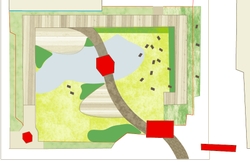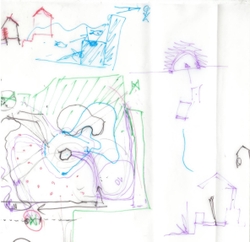„What makes China Town and What are the most crucial elements for China Town?“
In that essay I would like to discuss the title: What makes China Town? And outline elements which are crucial for the Chinese street view.
Manchester’s Chinatown is located in central area of the city. The boundaries of that area are easy to recognize. The density of chinese shops and restaurants is changing fluently from the Chinese Arch to domestic Manchester sourounding. Visitors can recognize that space because of hudge range of elements, which makes that place has identity.
„The area is compact enough to retain a real sense of community and camaraderie but diverse enough to offer a rich and varied experience. „ Ref. VirtualTurist
If we look back at the Faulkner Street scene we can recognize the Chinese Archways
- the most typical, architectural element which „makes China Town“.
Those beautifule gates has got always two, or more decorative pillars, and roof. That land mark is useful to outline the differences between China Town and the rest of the city. That also shows the pride and wealth of Chinese community.
„In architectural terms, it is important that buildings should promote identity: that is, the individuality of each cityzen. (...) Like individuals cities should have character and flavour, this flavour is made up of numerous chracteristic, or identifable elements.“
ref. [Crosby,1965:16]
In many buildings of China Town - houe, shop, office and workshop areas are mixed. Multifunction spaces and compexity, allow people to live in the China Town and it also make that place unique. Despite the low quality of public space there is a hudge number of outdoor activities. Colorful and dense advertising, bright neons and decorated shops windows can attract people from hudge distant. Streets are not pedistrianize but the movement of cars is low which allow people to cruising around.
Unfortunatelly China Town has not get many resting areas. Local sociecy has not get an opportunity to enjoy summer weather or spend a break between rush hours. There are only seven banks in the nearest suronding of Chinese Arch. Lack of resting places can limit the number of social contacts between cityzens. It can also decrease the numer of turists in that area.
The greenness in China Town is restricted too. Narrow streets and pavings do not allow any space for plants or trees. There is no doubt that planting can improve macroclimate and psyhical health of Chinese people.
Because of cultural meaning and street views China Town is one of the main Manchester’s atractions. Mancunians and turists fom all Europe are comming to taste Chinese cusine or take a look on Chinese Arch. Multistory buildings provides good background for colorful avertisemens and daily life. I am sure that condition of outdoor space depends on proper development in future. I am sure that Manchester’s China Town will be representativ for further generations, like it is today.
BIBLIOGRAPHY
BOOKS:
Crosby, Theo, 1965, Architecture: City Sence, Studio Vista London, New York.
Gehl, Jan, 2011 , Live between buildings, Island Press, London.
ONLINE REFERENCES:
[VirtualTurist, available from:(http://www.virtualtourist.com/travel/Europe/United_Kingdom/England/Greater_Manchester/Manchester-308843/Things_To_Do-Manchester-Chinatown-BR-1.html), accesed on 05/05/14]
In that essay I would like to discuss the title: What makes China Town? And outline elements which are crucial for the Chinese street view.
Manchester’s Chinatown is located in central area of the city. The boundaries of that area are easy to recognize. The density of chinese shops and restaurants is changing fluently from the Chinese Arch to domestic Manchester sourounding. Visitors can recognize that space because of hudge range of elements, which makes that place has identity.
„The area is compact enough to retain a real sense of community and camaraderie but diverse enough to offer a rich and varied experience. „ Ref. VirtualTurist
If we look back at the Faulkner Street scene we can recognize the Chinese Archways
- the most typical, architectural element which „makes China Town“.
Those beautifule gates has got always two, or more decorative pillars, and roof. That land mark is useful to outline the differences between China Town and the rest of the city. That also shows the pride and wealth of Chinese community.
„In architectural terms, it is important that buildings should promote identity: that is, the individuality of each cityzen. (...) Like individuals cities should have character and flavour, this flavour is made up of numerous chracteristic, or identifable elements.“
ref. [Crosby,1965:16]
In many buildings of China Town - houe, shop, office and workshop areas are mixed. Multifunction spaces and compexity, allow people to live in the China Town and it also make that place unique. Despite the low quality of public space there is a hudge number of outdoor activities. Colorful and dense advertising, bright neons and decorated shops windows can attract people from hudge distant. Streets are not pedistrianize but the movement of cars is low which allow people to cruising around.
Unfortunatelly China Town has not get many resting areas. Local sociecy has not get an opportunity to enjoy summer weather or spend a break between rush hours. There are only seven banks in the nearest suronding of Chinese Arch. Lack of resting places can limit the number of social contacts between cityzens. It can also decrease the numer of turists in that area.
The greenness in China Town is restricted too. Narrow streets and pavings do not allow any space for plants or trees. There is no doubt that planting can improve macroclimate and psyhical health of Chinese people.
Because of cultural meaning and street views China Town is one of the main Manchester’s atractions. Mancunians and turists fom all Europe are comming to taste Chinese cusine or take a look on Chinese Arch. Multistory buildings provides good background for colorful avertisemens and daily life. I am sure that condition of outdoor space depends on proper development in future. I am sure that Manchester’s China Town will be representativ for further generations, like it is today.
BIBLIOGRAPHY
BOOKS:
Crosby, Theo, 1965, Architecture: City Sence, Studio Vista London, New York.
Gehl, Jan, 2011 , Live between buildings, Island Press, London.
ONLINE REFERENCES:
[VirtualTurist, available from:(http://www.virtualtourist.com/travel/Europe/United_Kingdom/England/Greater_Manchester/Manchester-308843/Things_To_Do-Manchester-Chinatown-BR-1.html), accesed on 05/05/14]
Posted 13 May 2014 23:49





